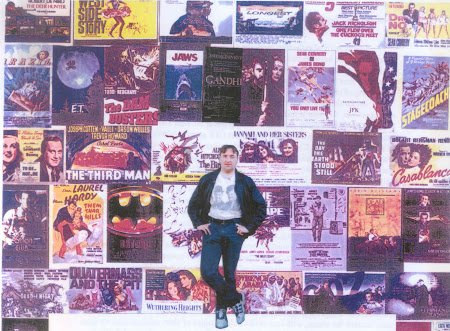For me, the Bond films are an acquired taste. Very formulaic, and rigidly so until Casino Royale in 2006. With their variations, the Bond formula generally seems to run as follows:
1. The opening shot (literally) through a gunsight
2. The pre-credits sequence
3. The titles and theme song
4. The mission set-up (with M and Q)
5. Meeting the villain and Bond Girl No. 1
6. Meeting Bond Girl No. 2
7. The finale
 All these elements found their ideal mixture in Goldfinger in 1964, the defining film of the series which also had one of Bond's most formidable adversaries, with Sean Connery at his most assured in the central role from first scene to last.
All these elements found their ideal mixture in Goldfinger in 1964, the defining film of the series which also had one of Bond's most formidable adversaries, with Sean Connery at his most assured in the central role from first scene to last.He may not be the exact Bond as written in the books, but as with so many good actors' interpretation of a role, Connery is the image that has stayed in the minds of cinemagoers, and which all subsequent Bond actors in the role have since had to emulate.
It probably helped Sean that he had actors the stature of Honor Blackman to deal with, fresh from The Avengers, as Pussy Galore - probably the most outrageously named character in the movies.
And then there is Goldfinger himself - brilliantly played by Gert Frobe in a role which set up his international film career - and his equally sadistic Oddjob, memorably played by Japanese American wrestler Tokiyushi "Harold" Sakata, with a nice line in sly grins and a lethal bowler hat.
Goldfinger is not a supervillain per se, but one who is sadistic enough to leave Bond to die in a famous laser execution scene - nothing at all to do with the Ian Fleming novel, but one of a number of the film's beautiful conceits.
In Fleming's novel there was an unsuccessful attempt to raid Fort Knox - but this was the 1960s, the era of John F. Kennedy, the civil rights movement, and the emerging space age, when all things were possible, and in director Guy Hamilton's eyes, the idea of a break-in not working would be understandably anti-climactic to the cinema audience. There are various ludicrous twists such as the nerve gas sprinkled over the fortress only having a limited effect, but the film carries you along with enough suspense to make it look as if Goldfinger is really going to succeed in his elaborate scheme. For me, it's easily the most enjoyable of the series.
Thereafter, the Bond films went on an artistically downward (but financially upward) spiral of increasingly fantastic plots, gimmicky gadgets, and self-parody, but those that succeeded King Connery have their various interesting slants on the character. Connery's unfortunate successor was George Lazenby, who by his own admission couldn't act, and worse still had the challenge of emotional scenes that neither Bond or Connery had ever ventured into. Nevertheless, On Her Majesty's Secret Service remains one of the most underrated of the series.
 For many, Roger Moore became the Bond they most associated with, certainly the longest serving, from 1973 through to 1985. His laid back style fitted into the tuxedo easily, from his grounding on The Saint and other suave film and TV shows. So what if the sight of a car becoming a submarine was a bit daft - Moore was enjoying himself, and so were the audience.
For many, Roger Moore became the Bond they most associated with, certainly the longest serving, from 1973 through to 1985. His laid back style fitted into the tuxedo easily, from his grounding on The Saint and other suave film and TV shows. So what if the sight of a car becoming a submarine was a bit daft - Moore was enjoying himself, and so were the audience. The unluckiest of the Bonds was probably Timothy Dalton, who only had two refreshingly action-packed stabs at the character in The Living Daylights and Licence to Kill, before contractual difficulties, the transition of the Broccoli legacy from one generation to the next, and the dismantling of the Iron Curtain, meant that Bond laid low for a while. When he returned, it was in the shape of suave Pierce Brosnan , who like Roger Moore had done his groundwork on TV in the likes of Remington Steele. Up until Goldeneye in 1995, he was - next to Cary Grant - the Best Bond That Never Was.
The unluckiest of the Bonds was probably Timothy Dalton, who only had two refreshingly action-packed stabs at the character in The Living Daylights and Licence to Kill, before contractual difficulties, the transition of the Broccoli legacy from one generation to the next, and the dismantling of the Iron Curtain, meant that Bond laid low for a while. When he returned, it was in the shape of suave Pierce Brosnan , who like Roger Moore had done his groundwork on TV in the likes of Remington Steele. Up until Goldeneye in 1995, he was - next to Cary Grant - the Best Bond That Never Was.
When Brosnan cited Goldfinger as being his main artistic inspiration for becoming an actor, things had come full circle. Now Daniel Craig has, for better or worse (and mostly better), taken on the role deep into the 21st century and the post-Cold War years. The plots are becoming more baffling, the gadgets are gradually escalating once again, and in this Size Zero supermodel age there's always plenty of opportunity for more Bond girls (Barbara Bach, Grace Jones, Carey Lowell, Michelle Yeoh and Halle Berry among the most notable), so the formula is looking good after 50 years of repackaging.

Goldfinger was the peak of Bond's cinematic accomplishments, but there's still life in the old dog yet.
.jpg)








No comments:
Post a Comment